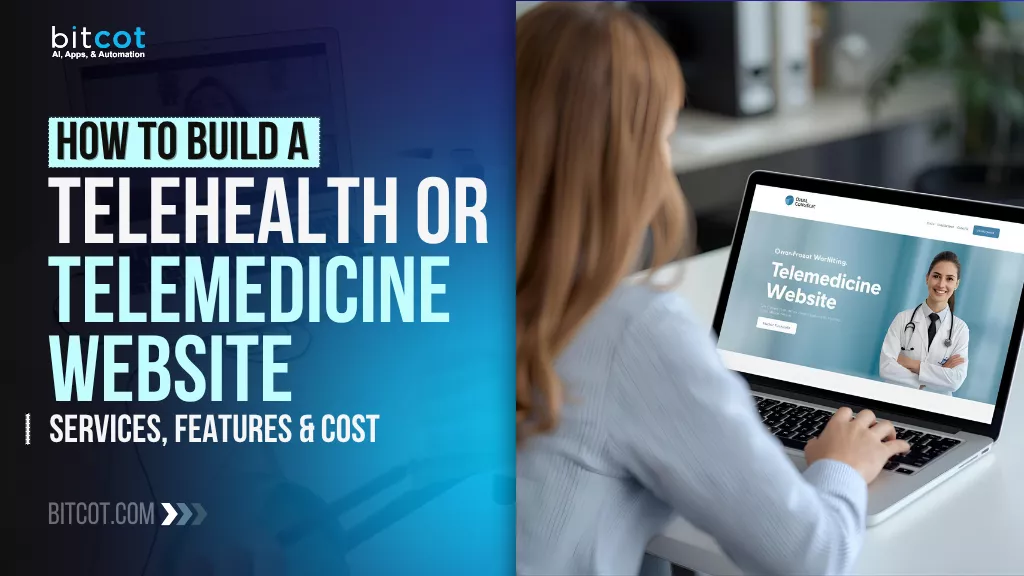
Patients are reaching out from everywhere: your website, WhatsApp, mobile app, and even social media, all expecting instant access to care
But if your systems don’t connect, every consultation starts from scratch. Your doctors re-enter patient data, your staff scramble to schedule appointments, and your patients wait longer for help.
Sound familiar?
Today’s patients expect convenient, secure, and seamless telehealth experiences, anytime, anywhere. When your platform can’t deliver, you risk losing both trust and revenue.
In this post, we’ll walk through exactly how to build a telehealth or telemedicine website, from defining core services and must-have features to understanding development costs and compliance requirements.
You’ll get clear examples, practical steps, and a simple roadmap you can apply right away.
Ask yourself:
- How many appointments are lost because of clunky scheduling?
- How often do patients struggle to connect with doctors online?
- You already see these gaps, but what’s your plan to fix them?
Whether you’re a healthcare provider, startup founder, or part of a medical tech team, this challenge is real. Every minute of delay means a missed opportunity to deliver better care.
Telehealth platforms are transforming how healthcare is delivered. They connect patients and doctors, streamline workflows, and ensure secure, on-demand access to medical expertise.
Bitcot helps you make that transformation. We build custom telehealth solutions that integrate seamlessly, protect patient data, and scale with your business.
The future of healthcare is virtual. Are you ready to build it?
Key Features of a Telehealth or Telemedicine Website
A robust and user-friendly website is the foundation of any successful telehealth or telemedicine service. It needs to serve multiple users: patients, doctors, and administrators, while maintaining strict adherence to privacy and security standards.
Here are the essential features that define a top-tier telehealth platform:
1. Patient-Centric Features (The Front-End)
These elements focus on a seamless and intuitive patient experience:
Easy Registration and Profile Management:
- Simple Sign-up: Quick and secure process using email, social media, or phone number.
- Comprehensive Patient Dashboard: A personalized space where patients can view upcoming appointments, prescription history, and billing statements.
Intuitive Appointment Scheduling:
- Provider Directory and Filters: Allows patients to search for doctors by specialty, availability, rating, and language.
- Real-time Calendar Integration: Shows a provider’s up-to-the-minute availability and allows for instant booking.
- Automated Notifications: Email, SMS, or in-app reminders for upcoming appointments and follow-ups.
Secure Payment Gateway:
- Multiple Payment Options: Support for credit/debit cards, digital wallets, and insurance co-pays.
- Transparent Billing: Clear, itemized invoices and the ability to process insurance claims.
Virtual Waiting Room:
- A dedicated, secure space where patients wait for their consultation to begin. Can include a countdown timer, brief health-related content, or pre-check forms.
2. Provider/Doctor-Focused Features (The Back-End)
These tools are designed to streamline a doctor’s workflow and enhance care delivery:
Electronic Health Record (EHR) Integration:
- Digital Patient Charts: Easy access to a patient’s medical history, lab results, and previous consultation notes.
- e-Prescribing: The ability to digitally send prescriptions directly to a patient’s preferred pharmacy.
Advanced Scheduling & Practice Management:
- A dedicated doctor calendar to manage and block out availability.
- Tools for tracking billable hours, performance metrics, and patient load.
Secure Communication Channels:
- Provider-to-Provider Chat: Secure messaging for internal consultations or referrals.
- Patient Triage Tools: Systems that help prioritize patients based on the urgency of their symptoms.
3. Core Telehealth Technology
This is the non-negotiable technology that powers the virtual visit itself:
High-Quality Audio and Video Conferencing:
- Built-in Video Platform: A secure, in-app solution that doesn’t require third-party downloads.
- Screen Sharing & Annotation: Tools for doctors to share medical images or draw on the screen to explain conditions.
- Recording Capabilities (with consent): For future review or training purposes.
Remote Patient Monitoring (RPM) Integration:
- The ability to connect with and receive data from wearable devices (like smartwatches, blood pressure cuffs, or glucose monitors) to track patient metrics remotely.
4. Security and Compliance Features (The Foundation)
Due to the sensitive nature of health data, absolute security is paramount.
- HIPAA/GDPR/PIPEDA Compliance: Adherence to all relevant regional and international health data privacy laws. This is not optional.
- End-to-End Encryption: All data, from video calls to stored records, must be encrypted both in transit and at rest.
- Secure Authentication: Multi-Factor Authentication (MFA) for both patients and providers to prevent unauthorized access.
- Regular Security Audits: Continuous testing to identify and patch vulnerabilities.
A successful telehealth website isn’t just a video chat platform; it’s a secure, integrated digital clinic. By prioritizing these key features, your platform will deliver convenience for patients and efficiency for providers, paving the way for the future of healthcare.
How to Build a Telehealth or Telemedicine Website in 6 Steps
Building a compliant and effective telemedicine platform requires careful planning. It’s more than just adding video chat; it’s about creating a safe, scalable, and secure digital environment for healthcare.
Follow this 6-step roadmap to guide your development process:
Step 1: Define Your Niche, Scope, and MVP
Before writing a single line of code, you must define the “why” and the “what.”
Market Analysis & Niche: Don’t try to serve everyone. Will your platform focus on mental health, chronic condition management (RPM), urgent care, or specialty consultations (e.g., dermatology)? Defining a clear niche targets your marketing and simplifies feature prioritization.
Define User Journeys: Map out the experience for your three primary users: Patient (booking, attending visit, paying), Provider (logging in, seeing schedule, writing notes, prescribing), and Admin (managing users, viewing analytics).
Create the MVP (Minimum Viable Product): Identify the absolute core features you need to launch. This usually includes:
- Secure Patient/Doctor Login
- Basic Profile Management
- Appointment Scheduling
- Secure, Encrypted Video Consultation
- Simple Payment Integration
Step 2: Ensure Compliance is the Foundation
Legal compliance is the most crucial, non-negotiable step. Failure here results in massive fines and loss of user trust.
| Jurisdiction | Key Regulation | Focus |
| U.S. | HIPAA (HITECH Act) | Protecting PHI (Protected Health Information). Requires encryption of data at rest and in transit, access control (role-based access), and audit logs. |
| EU/UK | GDPR | Governs how personal data is collected, processed, and stored. Requires explicit user consent, data minimization, and the “Right to Erasure.” |
- Business Associate Agreements (BAA): Any third-party vendor you use (cloud host, video API, payment processor) that handles PHI must sign a BAA.
- Licensing & Credentialing: Be aware of state and national laws regarding where a provider must be licensed (often both the patient’s state and the provider’s state).
Step 3: Choose Your Technology Stack
The right tech stack determines your platform’s security, scalability, and speed. Working with experts in telemedicine software development services ensures you select technologies that meet both clinical and technical requirements.
| Component | Recommendation | Why It Works for Telehealth |
| Front-End (Web) | React, Angular, or Vue.js | Excellent for building complex, data-heavy, single-page applications (SPAs) like doctor dashboards and patient portals. |
| Back-End (Server) | Node.js (with Express) or Python (with Django) | Node.js is fast and efficient for handling many simultaneous connections (video/chat). Django offers robust, built-in security features. |
| Database | PostgreSQL (Relational) or MongoDB (NoSQL) | PostgreSQL is excellent for structured medical data (EHR/billing). MongoDB can handle unstructured data like consultation notes and images. |
| Video/Real-time | Dedicated APIs (e.g., Twilio Video, Agora) or WebRTC | These handle the complex, low-latency, peer-to-peer connection required for medical video calls and are often designed with compliance in mind. |
| Cloud Hosting | AWS, Google Cloud (GCP), or Azure | These providers offer the high-level security, scaling, and compliance certifications (like HIPAA readiness) required for health data storage. |
Step 4: Focus on Secure UX/UI Design
Since users are often stressed or unwell, the interface must be highly accessible, intuitive, and reassuring.
- Prioritize Accessibility (WCAG): Ensure your site adheres to Web Content Accessibility Guidelines, including proper keyboard navigation and screen reader compatibility.
- Mobile-First Design: Given that most patients access healthcare via mobile devices, design the layout for smartphones first, then scale up to desktop.
- Security Trust Indicators: Clearly display security badges, use HTTPS, and implement Multi-Factor Authentication (MFA) at login to reassure users that their data is protected.
- Intuitive Workflow: Minimize clicks between a patient logging in and starting their appointment. For providers, reduce manual data entry through smart forms and template use.
Step 5: Development, Integration, and Quality Assurance (QA)
This is the phase where the code is written and integrated with essential third-party services.
- EHR Integration: Integrate your platform with existing Electronic Health Record systems (using standards like HL7 or FHIR) to allow doctors to access a patient’s full medical history seamlessly.
- Payment Gateway: Use a secure, compliant service (like Stripe Healthcare) to handle billing and co-pays.
- Rigorous Security Testing: Conduct vulnerability scanning and penetration testing before launch. Have security experts specifically test for compliance gaps (e.g., ensuring PHI cannot be viewed in unencrypted formats).
Step 6: Deployment, Launch, and Iteration
Your platform must be highly available and monitored 24/7.
- Scalable Deployment: Deploy using containerization tools (Docker, Kubernetes) on your cloud provider (AWS/GCP/Azure) to ensure your service can handle sudden spikes in user load.
- Pilot Program: Launch to a small, controlled group of users (a pilot program) to gather real-world feedback on usability, workflow, and bug detection before a full public launch.
- Continuous Monitoring: Establish continuous monitoring for performance (video quality, load times) and security (audit logs, unauthorized access attempts).
By treating compliance as a core feature and designing with both the patient and the provider in mind, you can build a stable, successful, and enduring telehealth platform.
Core Services Offered in Telehealth Website Development
Building a telehealth website requires more than good design; it demands reliable technology, secure data handling, and thoughtful integration across systems.
The development process typically involves several core services that work together to create a safe and user-friendly digital healthcare platform.
1. Custom Platform Development
A telehealth website should be tailored to the specific goals of the healthcare organization. Developers start by defining the system architecture, selecting frameworks, and building the core infrastructure that supports virtual consultations, patient management, and secure communication.
This stage ensures the platform is scalable, maintainable, and flexible enough to support future features or integrations. The goal is a foundation that balances functionality, performance, and security from the ground up.
2. User Interface and Experience Design (UI/UX)
A strong design makes digital healthcare easier to navigate for both patients and providers. UI/UX development focuses on creating simple, accessible, and responsive layouts that guide users through booking, consultation, and follow-up processes.
Designers prioritize readability, intuitive navigation, and compliance with accessibility standards. The outcome is a platform that minimizes confusion and builds trust through clarity and consistency.
3. Secure and Compliant Development
Telehealth systems handle highly sensitive personal data, so security must be embedded at every stage. Development teams implement compliance measures such as HIPAA, GDPR, or regional healthcare regulations, depending on where the platform operates.
Data encryption, secure authentication, and controlled user permissions are standard practices. This ensures that patient privacy is maintained while meeting legal and ethical requirements.
4. Real-Time Communication Integration
The ability to connect patients and healthcare professionals in real time is central to telehealth. Developers integrate video, voice, and chat functionality using technologies such as WebRTC or trusted communication APIs.
The focus is on achieving low latency, stable connectivity, and device compatibility across browsers and networks. Testing across conditions helps ensure that consultations remain reliable and high-quality for all users.
5. Electronic Health Record (EHR) and EMR Integration
Access to patient information directly within the platform is essential for effective virtual care. Integration with existing EHR or EMR systems allows healthcare providers to view records, update notes, and maintain accurate data without switching between tools.
Developers use APIs or secure data exchange protocols to enable this connection. Consistent synchronization helps reduce errors and improve clinical decision-making.
6. Appointment and Scheduling System Development
Efficient scheduling tools are key to managing consultations and reducing administrative workload. Developers build modules that allow patients to view available time slots, book or reschedule appointments, and receive automated reminders.
The system may also support time zone adjustments and integration with external calendars. The objective is to create a smooth, self-service process for both patients and healthcare staff.
7. E-Prescription and Pharmacy Integration
Many telehealth platforms include a secure way for doctors to send prescriptions digitally. This service involves building or integrating a prescription management module that connects to pharmacy systems or third-party APIs.
Data security and compliance are maintained throughout the exchange. The result is faster, more accurate prescription processing and improved convenience for patients.
8. Payment Gateway and Billing Integration
To support consultations and services, telehealth websites often include online payment systems. Developers integrate secure payment gateways that comply with PCI DSS standards and handle multiple payment methods.
In some cases, integration with insurance or billing systems is added for automated claim processing. Each transaction is encrypted and logged to ensure transparency and trust.
9. Admin Dashboard and Reporting Tools
Administrators need visibility into platform activity and performance. Developers create dashboards that consolidate data from users, appointments, and payments into one interface.
Reporting tools generate insights about usage, satisfaction, and operational efficiency. This helps healthcare teams manage users, track outcomes, and make informed improvements over time.
10. Maintenance and Scalability Support
Telehealth platforms must stay reliable and adapt to growing user demand. After launch, ongoing development includes software updates, security monitoring, and performance optimization.
Developers plan for horizontal and vertical scaling to handle more users, data, and new features as the service expands. Consistent maintenance ensures long-term stability and compliance with evolving healthcare standards.
Cost Factors in Building a Telehealth or Telemedicine Website
The investment required to develop a robust, custom telehealth solution varies widely, typically ranging from $150,000 to over $450,000 for a full-featured platform.
The final cost is driven by four primary factors.
1. Platform Complexity and Feature Set
The number and difficulty of the features you include are the single biggest cost driver.
| Feature Type | Cost Impact | Examples |
| Basic MVP Features | Low to Moderate | User authentication (email/password), simple appointment scheduling, secure peer-to-peer video calls, and basic patient/doctor profiles. |
| Medium Features | Moderate to High | Digital prescription management (eRx), secure in-app messaging, simple payment gateway integration, and comprehensive patient history access. |
| Advanced Features | Very High | AI-driven symptom checkers/triage, Remote Patient Monitoring (RPM) data ingestion, multi-party calls (for family/specialists), complex analytics dashboards. |
Key Takeaway: A core MVP built for a single platform (web-only) can cost significantly less than a cross-platform solution (web, iOS, and Android) incorporating advanced features.
2. Regulatory Compliance and Security
In healthcare, security is not a feature; it’s a mandatory, high-cost requirement.
- HIPAA and GDPR Implementation: Achieving and maintaining compliance with privacy laws (like HIPAA in the U.S.) involves mandatory technical safeguards. This includes end-to-end data encryption (in transit and at rest), robust role-based access controls (RBAC), and comprehensive audit logging.
- Business Associate Agreements (BAA): Legal fees are incurred to secure BAA contracts with all third-party vendors (cloud hosts, video services) that handle Protected Health Information (PHI).
- Security Testing: Mandatory pre-launch services, such as penetration testing (Pen Testing) and security audits, must be factored into the budget to ensure compliance is airtight. This alone can add tens of thousands of dollars to the project.
3. Integration with Third-Party Systems
The cost of a platform rises steeply with the need to connect it to outside clinical and financial systems.
- EHR/EMR Integration: Connecting to popular Electronic Health Record systems (e.g., Epic, Cerner) using standards like FHIR is essential but complex. This requires deep technical expertise and often involves licensing fees and dedicated development hours for data mapping.
- Payment & RCM Integration: While basic payment platforms (like Stripe) have simple fees, integrating with specialized Revenue Cycle Management (RCM) and insurance verification APIs is costly due to the complex nature of medical billing logic.
- Video/Communication APIs: Using specialized, high-quality, and compliant video services (like Twilio or Agora) involves recurring subscription or usage fees on top of the initial integration cost.
4. Development Team and Ongoing Costs
The team composition and long-term responsibilities contribute heavily to the total spend.
- Team Location and Expertise: Hiring development teams in regions with higher hourly rates (North America, Western Europe) will increase costs compared to outsourcing to other regions. Furthermore, healthcare-specific IT expertise commands a premium.
- Team Composition: A core team typically requires a Project Manager, a UI/UX Designer, multiple Front-end and Back-end Developers, a QA Tester, and a DevOps/Security Specialist. A larger, specialized team means higher costs.
- Post-Launch Maintenance (Hidden Cost): This is often underestimated. You must budget 15% to 20% of the initial development cost annually for:
- Bug fixes and performance optimization.
- Regular security patches and compliance updates (laws change).
- Cloud hosting fees (AWS, GCP, Azure).
By meticulously detailing your required features and prioritizing regulatory compliance from the start, you can better control these core cost factors and plan for a financially viable telehealth solution.
Developing a telemedicine platform is a complex process that requires a balance of technology, compliance, and user experience.
Partnering with an experienced development team helps ensure that every part of the system, from secure video consultations to data integration, works together seamlessly.
Bitcot brings expertise in building healthcare technology solutions that align with industry regulations and patient needs. Our team has experience with secure web architectures, cloud-based infrastructures, and integration of third-party APIs for video conferencing, scheduling, and payments.
When working with Bitcot, development typically begins with a discovery phase, where requirements are gathered, workflows are mapped, and compliance needs are identified. This is followed by design and development, focusing on usability, performance, and data security.
After testing and deployment, ongoing support ensures your platform remains reliable, scalable, and compliant with evolving standards.
By collaborating with a technical partner familiar with both healthcare and software development, organizations can shorten development time, minimize risks, and deliver a better digital experience for patients and providers.
Bitcot’s approach focuses on creating telemedicine solutions that are secure, adaptable, and designed to grow alongside your services.
Final Thoughts
Healthcare is changing fast. Patients no longer want to wait weeks for an appointment or sit in crowded waiting rooms; they want care that fits their schedule.
That’s exactly what telemedicine delivers: connection, convenience, and continuity of care from anywhere.
But building a telehealth platform that truly works: one that’s secure, reliable, and easy to use takes more than good ideas. It takes careful planning, the right technology, and a clear understanding of how patients and providers interact online.
Maybe you already have a concept in mind. Maybe you’re still exploring what’s possible. Either way, this is the moment to start. The tools are ready, the demand is growing, and the future of healthcare is digital.
If you’re ready to take the next step, Bitcot can help you turn that vision into reality. With deep experience in custom healthcare web development, our team builds solutions that connect patients and doctors seamlessly, securely, and at scale.
Your patients are already online. It’s time your healthcare services met them there. Let’s build the future of care together.
Get in touch with our team.












